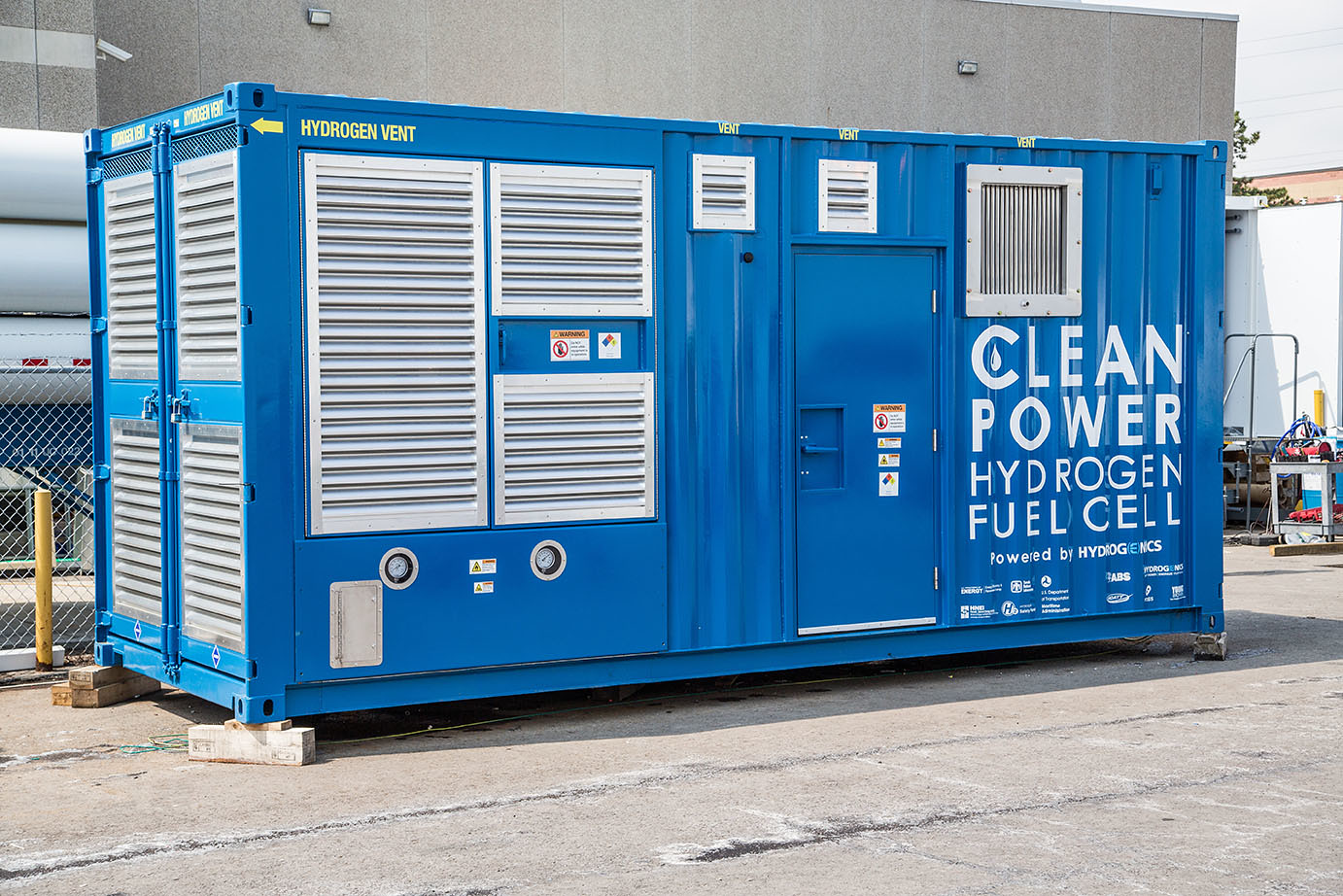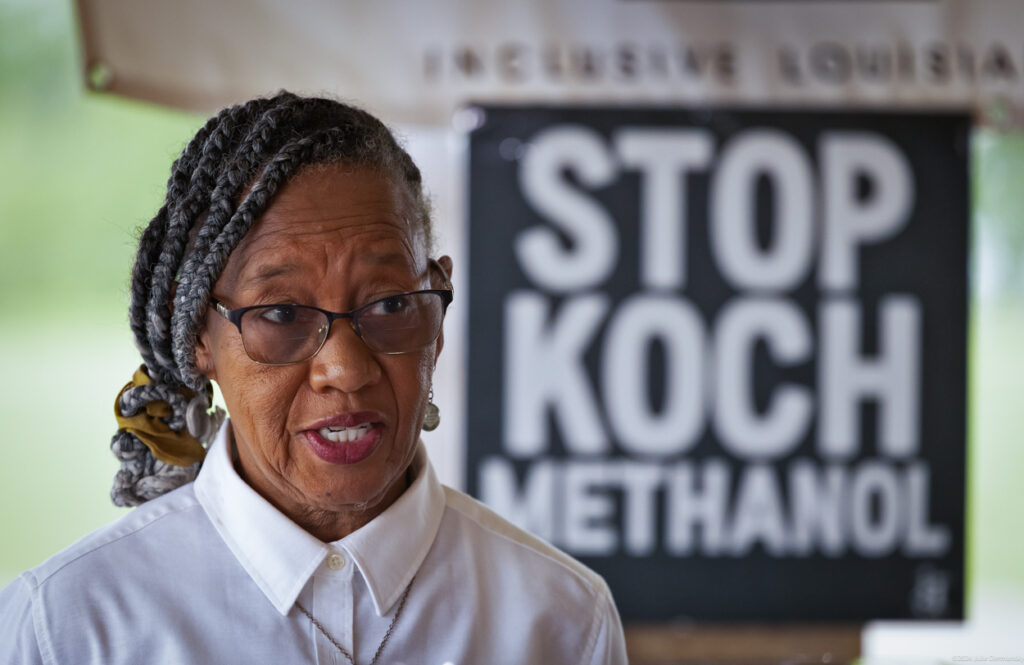The infrastructure bill signed into law by President Biden in November includes $9.5 billion dollars to support the creation of a clean hydrogen industry — but much of the money is going to support the U.S. fracked gas industry under the guise of “clean” blue hydrogen. While being presented as a clean hydrogen plan for decarbonizing the energy system, the main focus of the hydrogen section of the bill is to continue and expand the use of natural gas (that is, methane) in the U.S. economy via what’s known as blue hydrogen.
Blue hydrogen is the name for a fuel product that currently cannot be produced on a commercial scale. Hydrogen gets labeled different colors based on how it’s produced. There’s gray, made from fossil fuels, and green, made using renewable energy.
And then there’s blue. The theoretical idea is to make hydrogen from methane while using carbon capture technology to eliminate more than 90 percent of CO2 emissions released during the production process, thus making the hydrogen “low carbon.”
Most of the world’s current hydrogen is “gray,” produced from methane without carbon capture, which is an inexpensive but dirty process. Hydrogen production currently contributes to 2 percent of global CO2 emissions, in addition to all of the globe-warming methane released during natural gas production.
The gas industry is promising that carbon capture can eliminate most of the CO2 emissions associated with hydrogen production, but there is increasing evidence that carbon capture technology can’t deliver as promised and even if it could, it is very expensive.
Bloomberg recently reported that U.S. Senator Joe Manchin (D-WV) played a powerful role in shaping the components of the infrastructure bill that support the use of fracked shale gas as a feedstock for hydrogen production. However, even Manchin has recently admitted that carbon capture — which is essential to blue hydrogen’s supposed climate credentials — isn’t a realistic solution.
“I’d love to have carbon capture, but we don’t have the technology because we really haven’t gotten to that point,” Manchin explained to E&E. “And it’s so darn expensive that it makes it almost impossible.”
More recently the CEO of Italian energy company Enel acknowledged the same truth about carbon capture, stating: “The fact is, it doesn’t work.”
This reality about carbon capture’s failure, however, did not prevent the inclusion of $3.5 billion in subsidies to support carbon capture development for the fossil fuel industry in the infrastructure bill, in addition to the money earmarked for developing blue hydrogen. The Build Back Better bill, Biden’s signature climate and social policy legislation, also is full of more handouts to the fossil fuel industry to support carbon capture.
While the oil and gas industry’s public relations efforts attempt to sell the world on the false promise of blue hydrogen, actual clean hydrogen technology has made rapid technological and economical advancements that render blue hydrogen obsolete as a “clean” or low-cost solution.
Green hydrogen — made from water using renewable electricity — is where private money is focused, and the green hydrogen industry is experiencing rapid growth. The infrastructure bill does include funding for one clean hydrogen hub that utilizes renewable energy and one that uses nuclear energy, along with research money to improve these technologies. These are two viable pathways to make carbon-free hydrogen.
The oil and gas industry has hired the same public relations firms it used to push climate denial to now sell the world on blue hydrogen. Those efforts have initially paid off, with blue hydrogen funding in the infrastructure bill. However, the investing community and climate community both agree with Rep. Alexandria Ocasio Cortez’s (D-NY) recent conclusion on blue hydrogen: “Blue is bad.”
Blue Hydrogen as Gas Industry Lifeline
The appeal of blue hydrogen is easy to understand as it is sold as a way to use natural gas to produce energy that does not produce carbon emissions. However, like the industry promise that natural gas was a clean “bridge fuel” that would power the clean energy transition, this is another false promise
The natural gas industry is in trouble and knows it. At an industry conference this year, a slide from a presentation posed the question asking, “whether carbon capture and blue hydrogen would save the natural gas industry.” The answer to this question appears to be: No.
The new report “12 Insights on Hydrogen” released in November by the European think tank Agora Energiewende predicts that since hydrogen is unlikely to replace methane as a home heating fuel, the gas distribution industry should prepare for a “disruptive end to their business model.” Blue hydrogen is the gas industry’s rescue plan to avoid this fate, and the U.S. infrastructure bill reads like it was written for that purpose.
The language in the bill requires the identification of “economic opportunities for the production, processing, transport, storage, and use of clean hydrogen that exist in the major shale natural gas-producing regions.” The bill also requires “identifying opportunities using existing infrastructure, including all components of the natural gas infrastructure system … for clean hydrogen deployment.”
These are excellent ideas if the goal is to save the gas industry from a disruptive end but not if the goal is to reduce emissions of both carbon dioxide and methane.
The main problem with this approach is that even if carbon capture worked on a technical level and was cost-effective financially and producing blue hydrogen was possible, blue hydrogen is still not a clean fuel at the end of the day. As a result, blue hydrogen cannot be part of a clean hydrogen strategy whose true purpose is helping stave off catastrophic global heating.
A recent analysis by Robert Howarth, a biogeochemist at Cornell University, and Mark Jacobson, an environmental engineering professor at Stanford University, found that the methane emissions associated with blue hydrogen might make it dirtier than simply burning methane directly. And a new analysis by the business intelligence firm Fitch Solutions, acknowledges this reality and predicts the emissions associated with blue hydrogen will “constrain investment” in blue hydrogen — which is exactly what is happening.
Green Hydrogen Is the Clean Hydrogen Solution
According to Agora Energiewende’s new report, “Analysts agree, but not all lobbyists: the role of hydrogen for climate neutrality is crucial but secondary to direct electrification.”
Despite this, lobbyists for the gas industry continue to argue for a future where homes are heated with hydrogen, natural gas power plants are repurposed to burn hydrogen, and hydrogen plays a large role in light vehicle transportation.
Electrification and batteries are likely the best decarbonization solution for light vehicle transportation, building heating and cooling, and many other applications. The main argument for electrification instead of hydrogen for these applications is that it is a cheaper and more efficient solution.
While hydrogen will be necessary to completely decarbonize the U.S. and global economy, only green hydrogen, not blue, can deliver those results.
Emissions-free hydrogen is critical to decarbonization efforts. For instance, green hydrogen is also the only current viable path to decarbonize the steel industry — which accounts for 8 percent of global CO2 emissions. While the use of hydrogen to make green steel is still in its early stages, the technology is mature, and earlier this month plans were announced to build a new green steel facility on the Iberian Peninsula (either Spain or Portugal).
As has happened with renewable power generation and battery technology, the economics of green hydrogen are rapidly improving, and much faster than many expected. This trend has resulted in investors signaling that green hydrogen is the winning solution, and as a result, the industry is rapidly expanding, even before the promise of government incentives. This investment in expanding the green hydrogen economy is expected to lead to large decreases in the cost to produce green hydrogen in the next five years.
Green hydrogen has another advantage over hydrogen made from methane in that it isn’t dependent on the market price of a fossil fuel. The recent spike in methane prices in Europe has reportedly already made green hydrogen cheaper than methane-based hydrogen without carbon capture.
The new analysis of hydrogen markets done by Fitch highlights how green hydrogen is beating blue by a large margin, noting that in the global market there are currently 174 green hydrogen projects compared to just 15 for blue hydrogen. The new paper “Clean hydrogen? – Comparing the emissions and costs of fossil fuel versus renewable electricity based hydrogen” in the journal Applied Energy, concludes that for hydrogen production “electrolysis with renewable energy [green hydrogen] could become cheaper than fossil fuel with CCS options [blue hydrogen], possibly in the near-term future.”
Green hydrogen is currently technically possible and there is a wave of private investment around the globe that will rapidly expand the industry, driving large cost reductions. The only argument against green hydrogen is that right now, it is more expensive than methane-based hydrogen. However, 75 percent of the cost of green hydrogen production is the cost of the renewable electricity and 25 percent is the cost of the electrolyzers, which is expected to fall by 80 percent as the industry achieves scale. The rapidly falling cost of renewables is expected to make green hydrogen cheaper than gray hydrogen in many areas of the world by 2030.
The only valid argument for blue hydrogen has been that it was a cheaper alternative to clean green hydrogen. That argument is no longer valid, especially with the evidence showing that blue hydrogen is not “clean” by any standard and carbon capture technology is currently unable to change that.
The infrastructure bill’s focus on shale gas and blue hydrogen delays the efforts to decarbonize the fossil fuel-based economy and seeks to expand the use of natural gas in the U.S. The good news is that the markets have spoken and investors realize that despite efforts by the oil and gas industry and the politicians who do their bidding, the only path forward is green hydrogen.
Subscribe to our newsletter
Stay up to date with DeSmog news and alerts






